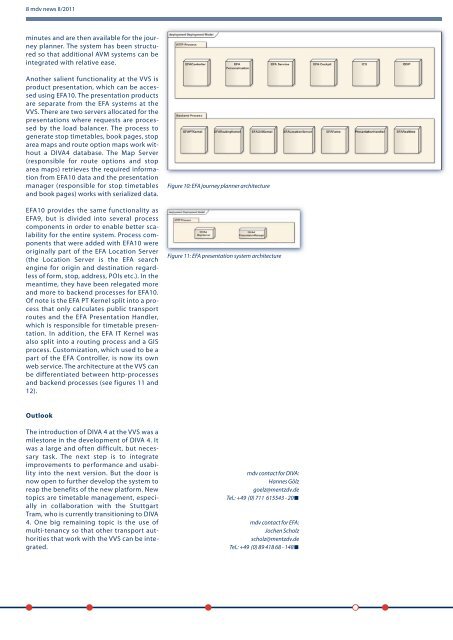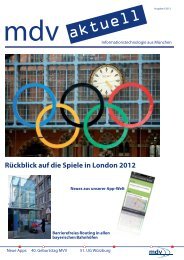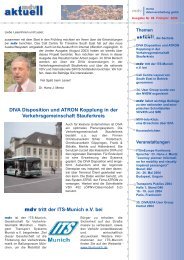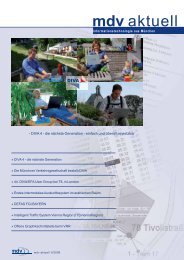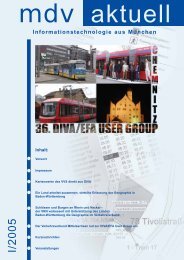DIVA 4 and EFA 10 - Paradigm Change at the VVS
DIVA 4 and EFA 10 - Paradigm Change at the VVS
DIVA 4 and EFA 10 - Paradigm Change at the VVS
Create successful ePaper yourself
Turn your PDF publications into a flip-book with our unique Google optimized e-Paper software.
8 mdv news II/2011<br />
minutes <strong>and</strong> are <strong>the</strong>n available for <strong>the</strong> journey<br />
planner. The system has been structured<br />
so th<strong>at</strong> additional AVM systems can be<br />
integr<strong>at</strong>ed with rel<strong>at</strong>ive ease.<br />
Ano<strong>the</strong>r salient functionality <strong>at</strong> <strong>the</strong> <strong>VVS</strong> is<br />
product present<strong>at</strong>ion, which can be accessed<br />
using <strong>EFA</strong><strong>10</strong>. The present<strong>at</strong>ion products<br />
are separ<strong>at</strong>e from <strong>the</strong> <strong>EFA</strong> systems <strong>at</strong> <strong>the</strong><br />
<strong>VVS</strong>. There are two servers alloc<strong>at</strong>ed for <strong>the</strong><br />
present<strong>at</strong>ions where requests are processed<br />
by <strong>the</strong> load balancer. The process to<br />
gener<strong>at</strong>e stop timetables, book pages, stop<br />
area maps <strong>and</strong> route option maps work without<br />
a <strong>DIVA</strong>4 d<strong>at</strong>abase. The Map Server<br />
(responsible for route options <strong>and</strong> stop<br />
area maps) retrieves <strong>the</strong> required inform<strong>at</strong>ion<br />
from <strong>EFA</strong><strong>10</strong> d<strong>at</strong>a <strong>and</strong> <strong>the</strong> present<strong>at</strong>ion<br />
manager (responsible for stop timetables<br />
<strong>and</strong> book pages) works with serialized d<strong>at</strong>a.<br />
<strong>EFA</strong><strong>10</strong> provides <strong>the</strong> same functionality as<br />
<strong>EFA</strong>9, but is divided into several process<br />
components in order to enable better scalability<br />
for <strong>the</strong> entire system. Process components<br />
th<strong>at</strong> were added with <strong>EFA</strong><strong>10</strong> were<br />
originally part of <strong>the</strong> <strong>EFA</strong> Loc<strong>at</strong>ion Server<br />
(<strong>the</strong> Loc<strong>at</strong>ion Server is <strong>the</strong> <strong>EFA</strong> search<br />
engine for origin <strong>and</strong> destin<strong>at</strong>ion regardless<br />
of form, stop, address, POIs etc.). In <strong>the</strong><br />
meantime, <strong>the</strong>y have been releg<strong>at</strong>ed more<br />
<strong>and</strong> more to backend processes for <strong>EFA</strong><strong>10</strong>.<br />
Of note is <strong>the</strong> <strong>EFA</strong> PT Kernel split into a process<br />
th<strong>at</strong> only calcul<strong>at</strong>es public transport<br />
routes <strong>and</strong> <strong>the</strong> <strong>EFA</strong> Present<strong>at</strong>ion H<strong>and</strong>ler,<br />
which is responsible for timetable present<strong>at</strong>ion.<br />
In addition, <strong>the</strong> <strong>EFA</strong> IT Kernel was<br />
also split into a routing process <strong>and</strong> a GIS<br />
process. Customiz<strong>at</strong>ion, which used to be a<br />
part of <strong>the</strong> <strong>EFA</strong> Controller, is now its own<br />
web service. The architecture <strong>at</strong> <strong>the</strong> <strong>VVS</strong> can<br />
be differenti<strong>at</strong>ed between http-processes<br />
<strong>and</strong> backend processes (see figures 11 <strong>and</strong><br />
12).<br />
Outlook<br />
The introduction of <strong>DIVA</strong> 4 <strong>at</strong> <strong>the</strong> <strong>VVS</strong> was a<br />
milestone in <strong>the</strong> development of <strong>DIVA</strong> 4. It<br />
was a large <strong>and</strong> often difficult, but necessary<br />
task. The next step is to integr<strong>at</strong>e<br />
improvements to performance <strong>and</strong> usability<br />
into <strong>the</strong> next version. But <strong>the</strong> door is<br />
now open to fur<strong>the</strong>r develop <strong>the</strong> system to<br />
reap <strong>the</strong> benefits of <strong>the</strong> new pl<strong>at</strong>form. New<br />
topics are timetable management, especially<br />
in collabor<strong>at</strong>ion with <strong>the</strong> Stuttgart<br />
Tram, who is currently transitioning to <strong>DIVA</strong><br />
4. One big remaining topic is <strong>the</strong> use of<br />
multi-tenancy so th<strong>at</strong> o<strong>the</strong>r transport authorities<br />
th<strong>at</strong> work with <strong>the</strong> <strong>VVS</strong> can be integr<strong>at</strong>ed.<br />
Figure <strong>10</strong>: <strong>EFA</strong> journey planner architecture<br />
Figure 11: <strong>EFA</strong> present<strong>at</strong>ion system architecture<br />
mdv contact for <strong>DIVA</strong>:<br />
Hannes Gölz<br />
goelz@mentzdv.de<br />
Tel.: +49 (0) 711 615543 - 20<br />
mdv contact for <strong>EFA</strong>:<br />
Jochen Scholz<br />
scholz@mentzdv.de<br />
Tel.: +49 (0) 89 418 68 - 148


